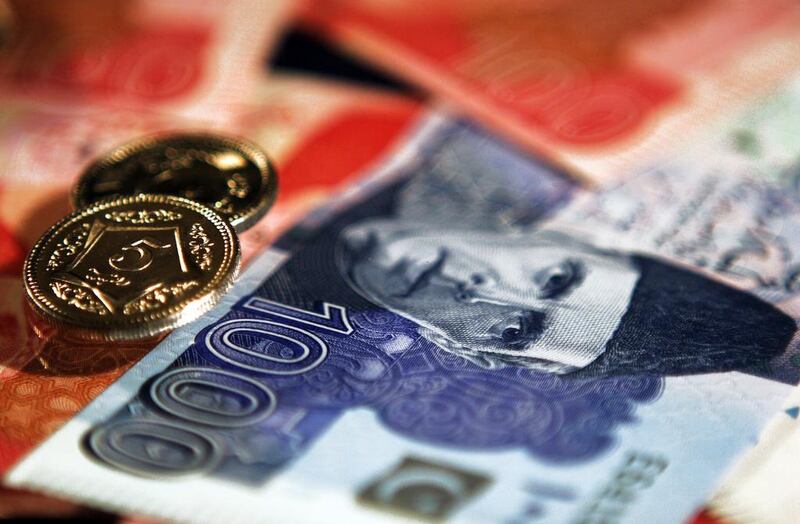Pakistan's central bank has temporarily halted the rupee's free fall against the US dollar, thanks to its recent monetary intervention. But the Pakistani currency will remain under pressure because of the country's worsening current account deficit, decreasing foreign direct investment inflows, rising cost of oil imports and dwindling foreign-exchange reserves due to the repayment of debt.
On September 26, State Bank of Pakistan bought as much as US$60 million of rupees to bolster the local currency, which has been among the worst performers in Asia in the past three months. That led to an unprecedented single-day fluctuation in the dollar's value, which fell to 105.50 rupees from 110.50 rupees that day.
Nevertheless, the rupee has weakened nearly 8.5 per cent against the dollar in the past three months. That reflects the government's inability to meet the IMF's demand for a decisive halt of the currency's decline – a condition the IMF attached to its approval on September 5 for a $6.6 billion bailout loan to Pakistan.
In addition, Pakistan's central bank's foreign exchange reserves now amount to just $6bn, only enough to cover imports for six weeks. As such, the central bank is not in a position to further shore up the value of the rupee.
True, the central bank's currency intervention provides a temporary cushion for the rupee's depreciation, but its market value cannot be stabilised and sustained over the long term without the government addressing the structural economic problems, money laundering and the smuggling of US dollars out of Pakistan.
In terms of imports, Pakistan's bill has been ballooning mainly because of its oil imports. Unfortunately, Pakistani exports have not risen in tandem with imports over the past decade. The value of Pakistani exports are about half that of the nation's imports.
The widening gap is contributing to the hollowing out of Pakistan's foreign exchange reserves, fuelling currency speculation.Islamabad should therefore take measures to increase exports and reduce its ever-rising import costs.
As Pakistan is heavily reliant on oil imports for its energy needs, the rupee's ongoing decline raises the country's cost of importing oil, which is priced in US dollars.
Meanwhile the goverment is unnerving Pakistanis by allowing tax officials to access the bank accounts of depositors. And in an effort to levy a 0.5 per cent income support tax, the government has made it mandatory for account holders to declare their cash holdings when they file their tax returns. That has prompted people to withdraw their funds from the banks.
A key reason for the rupee's devaluation against the dollar is the smuggling out of US dollars.
The central bank governor Yaseen Anwar recently told the senate standing committee on finance that funds of around $25m a day, or $9bn a year, are smuggled out of Pakistan through airports in Karachi, Lahore and Islamabad.
That is exacerbating the country's foreign-exchange reserves woes and the rupee's market value. If that figure is true, that means Pakistan is losing an amount equivalent to its total annual foreign exchange reserves.
To be sure, the rupee's depreciation is increasing Pakistan's public debt to the tune of 270bn rupees without additional borrowing. And without stemming the currency's decline, Islamabad will be unable to contain the ensuing inflation.
Now is the right time for Islamabad to do all it can to resolve this problem, because the current economic situation is worse than that in 1998 when international sanctions were imposed on Pakistan after it conducted nuclear tests. Even then, the rupee did not depreciate as significantly as it has over the past three months.
A possible solution is for the government to securitise monetary remittances from Pakistanis working abroad. That could shore up the government's fiscal position, enabling it to halt the rupee's slide and restore confidence in the currency.
Next, the government should incentivise Pakistanis to retain their bank deposits in rupees, as some may switch to foreign currency accounts to profit from the relative depreciation of the rupee.
And for good measure, the government should also impose a levy on foreign currency accounts as it did with rupee bank deposits.
Syed Fazl-e-Haider is a development analyst in Pakistan. He is the author of books including The Economic Development of Balochistan.
business@thenationa.ae
Time for decisive action from Islamabad to stem Pakistani rupee’s free fall
Now is the right time for Islamabad to do all it can to resolve the rupee's free fall, because the current economic situation is worse than that in 1998 when international sanctions were imposed on Pakistan after it conducted nuclear tests. Even then, the rupee did not depreciate as significantly as it has over the past three months.

Editor's picks
More from the national




